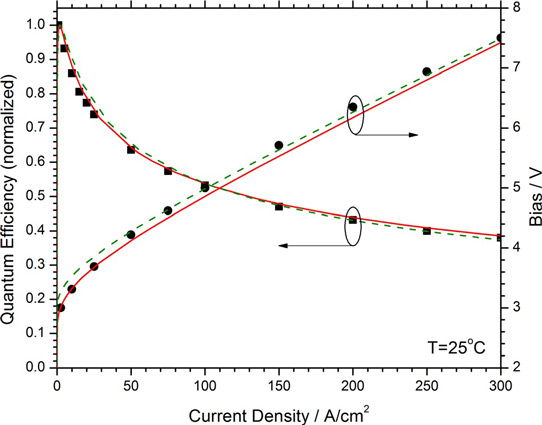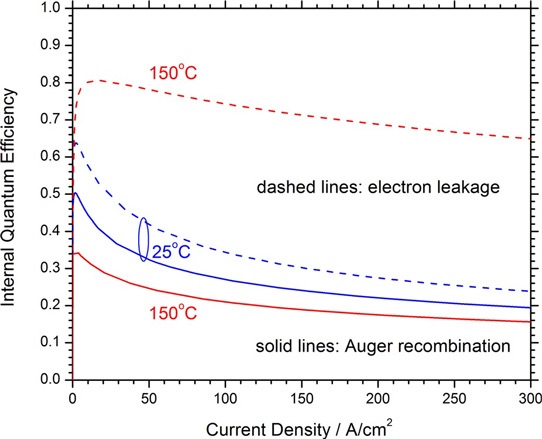- News
6 August 2015
Auger recombination primary cause of efficiency droop, say simulations
Joachim Piprek, founder & president of NUSOD Institute LLC in the USA, has run simulations that he believes eliminate electron leakage as the primary cause of efficiency droop at high current in blue light-emitting diodes (LEDs) [Appl. Phys. Lett., vol107, p031101, 2015]. In particular, Piprek suggests that electron leakage cannot explain the thermal degradation of LED performance at high temperature.
Piprek constructed two models based on different assumptions concerning the source of efficiency droop under pulsed measurements that avoid self-heating effects. The models are differentiated by the values of the Auger recombination coefficient and acceptor level in an aluminium gallium nitride (AlGaN) electron-blocking layer (EBL).
The Auger recombination coefficient reflects enhanced non-radiative recombination at high carrier densities in the indium gallium nitride (InGaN) multiple quantum well (MQW) active region of blue LEDs. This coefficient is much disputed, since simple microscopic models predict a value too low to account for efficiency droop. The simple models consist of the energy of recombination being transferred to another carrier. Various mechanisms have been suggested that could boost such non-radiative recombination.
Piprek comments; "The surprisingly strong Auger recombination in InGaN quantum wells is still not fully understood and further investigations are needed to clarify its influence. Recent simulations of compositional quantum-well fluctuations indicate Auger recombination enhancements by local carrier accumulation."
The acceptor level in the EBL alters the electron leakage into the magnesium-doped GaN contact regions. If there is a large density of ionized acceptors, the negative charge compensates positive polarization charges at the MQW/EBL interface. In reality, the ionization of p-AlGaN acceptors is low due to a high activation energy of the magnesium atoms. Electrons are accelerated towards the positive polarization charges and injected into the p-GaN cladding, where they recombine non-radiatively with holes.
The simulations were of a 440nm-wavelength device with five 3nm InGaN wells, p-Al0.13Ga0.87N EBL, and p-GaN cladding.
One model had a high ionized acceptor level of 1019/cm3 and high Auger coefficient of 5x10-30cm6/s. The high acceptor level effectively blocked electrons from entering the p-GaN cladding, and the efficiency droop was primarily caused by Auger recombination.
The second model had low ionization of the acceptors (2.6x1018/cm3) and low Auger recombination (10-34cm6/s), in line with expectations from simple microscopic considerations. Here, the droop was primarily from electron leakage into the p-GaN region.

Figure 1: Normalized quantum efficiency and bias versus current density at room temperature (symbols — measurement, solid lines — simulation favoring Auger recombination, dashed lines — simulation favoring electron leakage).
Both models were able to simulate room-temperature experiments performed by Rensselaer Polytechnic Institute and Samsung Electro-Mechanics (Figure 1). To distinguish between the models, Piprek increased the temperature to 150°C.
The efficiency of the Auger recombination model decreased, but the efficiency of the electron leakage model increased (Figure 2). Since experiment shows reduced efficiency of blue LEDs, Piprek concludes that the Auger recombination model is the primary cause of droop, although other factors, such as electron leakage, could have secondary influences.

Figure 2: Internal quantum efficiency versus current density calculated at different ambient temperatures (solid lines — simulation favoring Auger recombination, dashed lines — simulation favoring electron leakage).
Piprek admits that the increase in efficiency at high temperature for the electron leakage model is contrary to common assumptions. The reduced leakage in the model is due to enhanced hole transport emanating from increased acceptor ionization at high temperature.
The self-consistent simulations were based on advanced APSYS software and included a wide range of physical effects. NUSOD Institute runs the annual International Conference on Numerical Simulation of Optoelectronic Devices.
LED efficiency droop LEDs AlGaN InGaN GaN
http://dx.doi.org/10.1063/1.4927202
The author Mike Cooke is a freelance technology journalist who has worked in the semiconductor and advanced technology sectors since 1997.


